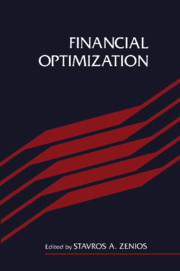Book contents
- Frontmatter
- Contents
- List of contributors
- Foreword
- Preface
- Acknowledgments
- Part I General overview
- Part II Models
- 5 An economic approach to valuation of single premium deferred annuities
- Commentary by D.F. Babbel
- 6 The optimal portfolio system: targeting horizon total returns under varying interest-rate scenarios
- 7 Optimization tools for the financial manager's desk
- 8 A flexible approach to interest-rate risk management
- 9 Currency hedging strategies for US investment in Japan and Japanese investment in the US
- Commentary by Y. Beppu
- Part III Methodologies
- Index
7 - Optimization tools for the financial manager's desk
Published online by Cambridge University Press: 09 February 2010
- Frontmatter
- Contents
- List of contributors
- Foreword
- Preface
- Acknowledgments
- Part I General overview
- Part II Models
- 5 An economic approach to valuation of single premium deferred annuities
- Commentary by D.F. Babbel
- 6 The optimal portfolio system: targeting horizon total returns under varying interest-rate scenarios
- 7 Optimization tools for the financial manager's desk
- 8 A flexible approach to interest-rate risk management
- 9 Currency hedging strategies for US investment in Japan and Japanese investment in the US
- Commentary by Y. Beppu
- Part III Methodologies
- Index
Summary
Building financial optimization models
The financial work presents interesting challenges to those who build optimization models and wish to implement them by developing the appropriate software. These challenges fall into two interrelated categories: first, the environment in which the model operates is, in most cases, a very risky one and the model's output is expected to be used almost instantaneously. Second, the software based on the model is most often required to be run by the end-user (e.g., a financial manager or a trader), without the intervention and expert advice of optimization specialists. The implication of the risky environment, as far as model development is concerned, is that failing to provide a correct recommendation for optimal action can have very serious financial consequences for the model's user. It is, therefore, vital that the model perform in a foolproof manner in all circumstances. The development of such a model is by no means trivial. For example, without some precautionary measures a very small change in the data input of an otherwise perfectly operating linear program can result in failing to find an optimal (or any feasible) solution and, as far as the end-user is concerned, this means failure. Such failures can be avoided by careful model formulation and by appropriate preprocessing of the problem data that detects inadmissible inputs.
Information
- Type
- Chapter
- Information
- Financial Optimization , pp. 176 - 188Publisher: Cambridge University PressPrint publication year: 1993
